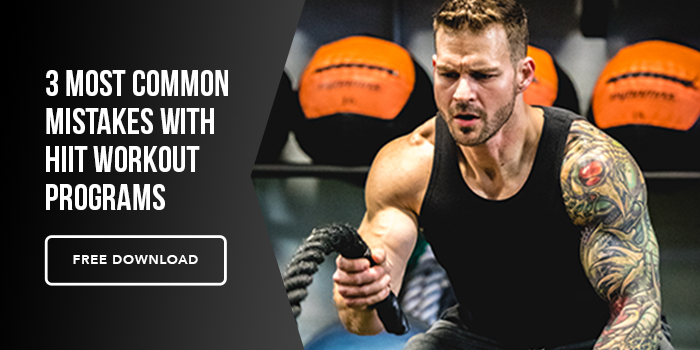It seems like trends and fads have plagued the fitness industry from the very beginning. Some of these fads came and went like the vibrating belt machines of the 1960s while others left a permanent mark in how we workout like the introduction of aerobic classes in the 1980s. The most recent big trend in the fitness space didn’t just leave a mark, it fundamentally changed how mainstream gyms look and operate. Of course, I am talking about CrossFit.
CrossFit came onto the scene and EXPLODED. In my entire career in fitness I had never seen anything influence the whole fitness space as strongly and fundamentally as CrossFit. In 2005 they only had 13 affiliated locations. Today there are over 13 THOUSAND.
Before CrossFit, it was extremely RARE to see anyone do a barbell squat. Squat racks collected dust and many gyms didn’t even have one. Barbell deadlifts were even more rare. In fact, anytime I would do a deadlift in a mainstream gym in the ’90s inevitably an adult would come up to me and scold me for damaging my spine (I was a 14 when I first started). Additionally, there were very few women that did any resistance training, and when they did, they stuck to machines and light weight high rep work.
Nowadays most mainstream gyms have multiple squat cages and women make up one third to half of the people in the free weight room. These are very GOOD things. Squats and deadlifts are two of the most effective and beneficial resistance training exercises known to mankind and weight training has tremendous health benefits for everyone, including women. I can confidently give CrossFit the credit for those amazing changes.
If you listen to my fitness podcast Mind Pump, you may be a bit confused reading this article. After all, my co-hosts and I routinely hammer CrossFit and we almost always recommend people stay away. I haven’t changed my mind. The vast majority of those of you who are reading this article should stay away from CrossFit. Although it did contribute some good to the fitness space, it also brought in some real bad. Two bad things to be exact. Below I list the two main reasons why CrossFit should be avoided.
It promotes an “intensity at all costs” mentality
I can’t stress this enough, harder is NOT always better. In fact, oftentimes harder is worse. The fitness principle of intensity (how hard you work out) is a very important one, however it must be used appropriately. In order to progress you need to train the RIGHT AMOUNT of hard and this measure is not only different for each person but its different for you today vs the right amount for you yesterday. One of the most important concepts a trainer can teach a client is to learn how to listen to their body to determine how hard they should train.
Workouts can cause muscle damage, and its largely believed that muscle damage is one way we signal the body to get stronger, build muscle and adapt. Your body does this as an attempt to prevent further damage from the same physical insult. This is great except that the healing and adapting process can easily be overwhelmed in most people, and always chasing intensity is a sure-fire way to do this.
Although the CrossFit instructor ultimately is responsible for proper training, the CrossFit environment and class-like structure promotes competition among trainees and rewards intensity. You are encouraged to beat the scores of others and many of your workouts are done for time. It’s a culture of intensity and breaking personal records which can increase risk of injury and cause people to over train regularly, resulting in sore muscles and less long-term results.
Olympic lifts to fatigue
Of all of the barbell and dumbbell exercises that exist, the most complex and difficult to master are the Olympic lifts. They can take fit people many months or sometimes even years to accomplish with good form. It can take much longer for a beginner. They are also some of the riskiest to perform. Not because they are inherently dangerous, but rather because they leave zero room for error. A perfectly performed snatch or clean that is done by a healthy capable person is safe, but if their form deviates even a tiny bit, those exercises become extremely precarious. The risk of injury combined with the high level of skill required to perform them is the reason very few experienced personal trainers and coaches teach Olympic lifts to their everyday regular clients.
If you want to see someone’s form break down in any exercise, just get them really tired. As you fatigue, your body compensates and your form begins to change. Not a big deal with exercises that don’t need to be done absolutely perfectly in order to be safe (like a curl), but any compensation can be a very big deal for some exercises and chief among them are the Olympic lifts.
CrossFit puts Olympic lifts in circuits (multiple exercises strewn together without rest) and has people doing them for time and/or high reps. This is a DISASTER. In this format, your form is going to break down, and each time it does you run into inappropriate levels of risk. Besides the risk of injury, doing Olympic lifts in this way almost completely negates the benefits these lifts are known for, namely explosiveness. In order to build explosiveness, you need to train explosive, and this can’t be done when you are fatigued. The bottom line is that CrossFit writes and programs terrible workouts that tend to have higher than appropriate levels of injury risk.
Unless you plan on competing in a CrossFit competition or you find a CrossFit coach who is also an Olympic lift specialist AND you are already very fit and mobile, I suggest you stay away from CrossFit. Instead, opt for traditional resistance training and adapt it to your goals and your body.






